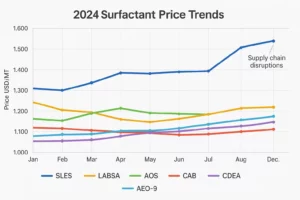The allure of shimmering, pearlescent beauty has captivated consumers in the personal care industry for decades. From luxurious shampoos to silky body lotions, that iridescent glow adds a touch of elegance and sophistication. But what’s the secret behind this mesmerizing effect? Enter Ethylene Glycol Distearate (EGDS) and Ethylene Glycol Monostearate (EGMS)—two indispensable ingredients that transform ordinary formulations into pearlescent wonders.
In this article, we’ll delve deep into the world of EGDS and EGMS, exploring their chemical properties, synthesis, benefits, and applications in personal care products. Whether you’re a formulator, a beauty enthusiast, or simply curious, read on to discover how these compounds are redefining beauty standards.
Understanding EGDS and EGMS
What Are EGDS and EGMS?
Ethylene Glycol Distearate (EGDS) and Ethylene Glycol Monostearate (EGMS) are ester compounds derived from the reaction of stearic acid with ethylene glycol. They are widely used in the cosmetics and personal care industry for their ability to impart a pearlescent appearance to formulations.
- EGDS is the diester of stearic acid and ethylene glycol.
- EGMS is the monoester of stearic acid and ethylene glycol.
The key difference lies in the number of stearic acid molecules attached to the ethylene glycol:
- EGDS has two stearic acid molecules.
- EGMS has one stearic acid molecule.
Chemical Properties
EGDS
- Chemical Structure: C₃₈H₇₄O₄
- Physical Appearance: White flakes
- Melting Point: 65–73°C
- Solubility: Insoluble in water
- Compatibility: Highly compatible with other surfactants
EGMS
- Chemical Structure: C₂₀H₄₀O₃
- Physical Appearance: Waxy solid or flakes
- Melting Point: 55–60°C
- Solubility: Slightly soluble in water
- Compatibility: Excellent compatibility with surfactants
Both compounds are known for their stability and low irritation profiles, making them suitable for sensitive skin formulations.
The Synthesis of EGDS and EGMS
Production Methods
EGDS
EGDS is typically produced through the esterification of stearic acid with ethylene glycol:
- Esterification Process: Stearic acid reacts with ethylene glycol in the presence of an acid catalyst.
- Formation of Diester: Two molecules of stearic acid bond with one molecule of ethylene glycol, forming EGDS.
- Purification: The product is then purified to obtain high-purity EGDS.
Alternatively, EGDS can be synthesized by reacting stearic acid with ethylene oxide, although this method is less common due to safety and regulatory concerns.
EGMS
EGMS is produced through a similar esterification process but yields a monoester:
- Controlled Reaction: By adjusting the molar ratios and reaction conditions, one molecule of stearic acid bonds with ethylene glycol.
- Formation of Monoester: This results in the formation of EGMS.
- Purification: The crude product undergoes purification steps to achieve the desired purity.
Quality Assurance
At Yeser Chemicals, we adhere to stringent quality control measures:
- Raw Material Selection: Only high-grade stearic acid and ethylene glycol are used.
- Process Control: Advanced equipment ensures precise control over reaction conditions.
- Testing: Each batch undergoes rigorous testing for purity, melting point, and other key parameters.
- Certifications: Our facilities comply with international standards such as ISO 9001 and GMP.
Benefits of EGDS and EGMS in Personal Care Products
Pearlescent Effect
How Do They Create the Pearlescent Look?
- Crystal Formation: Upon cooling, EGDS and EGMS crystallize into fine, lens-like platelets.
- Light Reflection: These crystals reflect and refract light, producing a shimmering, pearlescent appearance.
- Texture Enhancement: They also contribute to the viscosity and texture, giving products a luxurious feel.
The Science Behind It
- Anisotropic Properties: The crystalline structures are anisotropic, meaning they have different properties in different directions, enhancing light interaction.
- Layer Formation: The platelets align in layers within the formulation, amplifying the pearlescent effect.
Moisturizing Properties
Both EGDS and EGMS act as emollients, helping to:
- Hydrate the Skin: Form a protective layer that traps moisture.
- Improve Skin Texture: Leave the skin feeling soft and smooth.
- Enhance Product Spreadability: Improve the application experience.
Skin Gentleness
- Low Irritation Profiles: Suitable for sensitive skin and baby products.
- Dermatologically Tested: Both compounds are generally recognized as safe (GRAS) for topical applications.
Opacifying Performance
- Enhance Appearance: Impart a rich, opaque look to transparent formulations.
- Product Differentiation: Help distinguish products on the shelf through visual appeal.
Applications of EGDS and EGMS
Product Formulations
Shampoos
- EGDS: Preferred for high-end shampoos requiring a pronounced pearlescent effect.
- EGMS: Used in everyday shampoos for mild pearlescence and conditioning properties.
Body Lotions
- EGDS: Adds luxurious texture and visual appeal.
- EGMS: Enhances moisturizing properties and improves skin feel.
Facial Cleansers
- EGDS: Ideal for formulations targeting a premium market.
- EGMS: Suitable for gentle cleansers focusing on hydration.
Hand Soaps
- EGDS: Provides a rich lather and visual elegance.
- EGMS: Offers a balance between cost and performance.
Formulating Flexibility
- Compatibility: Both compounds are highly compatible with anionic, cationic, and non-ionic surfactants.
- Ease of Incorporation: They dissolve upon heating (above their melting points) and recrystallize upon cooling.
- Customization: By adjusting concentrations, formulators can control the degree of pearlescence and opacity.
Features and Advantages of Yeser Chemicals’ EGDS and EGMS
Superior Solubility and Compatibility
- Formulating Ease: Our products dissolve readily in surfactant mixtures when heated.
- Versatility: Suitable for a wide range of pH levels and formulations.
Outstanding Opacifying Performance
- Bright White Appearance: Achieve a clean, bright look in products.
- Soft Velvety Feel: Enhance the tactile experience for consumers.
Environmental Benefits
- Biodegradability: Both EGDS and EGMS have degradation rates of up to 97%, minimizing environmental impact.
- Hard Water Resistance: Maintain performance in varying water conditions.
Choosing Between EGDS and EGMS
Guidelines for Selection
Desired Pearlescent Effect:
- EGDS: For a more pronounced, luxurious shimmer.
- EGMS: For a subtle, satin-like glow.
Formulation Considerations:
- EGDS: Slightly higher melting point; consider heating parameters.
- EGMS: Lower melting point; easier to incorporate at lower temperatures.
Cost Implications:
- EGMS: Generally more cost-effective, making it suitable for mass-market products.
- EGDS: Offers premium benefits at a slightly higher cost.
Environmental Impact and Sustainability
Biodegradability
- Eco-Friendly Formulations: High biodegradability rates support environmentally conscious product development.
- Regulatory Compliance: Meets stringent environmental regulations globally.
Sustainable Sourcing
- Ethical Practices: Yeser Chemicals is committed to sourcing raw materials responsibly.
- Sustainability Initiatives:
- Reduction of carbon footprint through energy-efficient processes.
- Waste minimization and recycling programs.
Conclusion
EGDS and EGMS are more than just functional ingredients; they are transformative agents that elevate personal care products to new heights of luxury and performance. From imparting a mesmerizing pearlescent glow to enhancing moisturizing properties, these compounds play a pivotal role in modern formulations.
At Yeser Chemicals, we are proud to offer high-quality EGDS and EGMS that not only meet but exceed industry standards. Our commitment to quality, innovation, and sustainability ensures that you can create products that delight consumers while respecting the environment.






